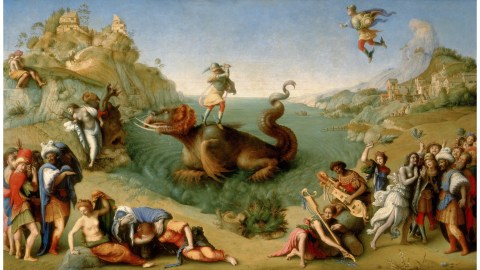Piero di Cosimo: Renaissance “Madman” for the Modern Age

Half a millennium later, you would think the Italian Renaissance could hold no more secrets from us, no “codes” to decipher. And, yet, secrets hiding in plain sight continue to startle modern audiences with the depth and breadth of that amazing era. One of the well-kept secrets, at least until now, was the work of Piero di Cosimo, subject of his first major retrospective, Piero di Cosimo: The Poetry of Painting in Renaissance Florence at the National Gallery of Art, Washington, DC. Called “a madman” for his personal and artistic quirks by Renaissance chronicler Giorgio Vasari, Piero’s ability to paint in multiple genres all with a dizzying amount of detail may have seemed madness to contemporaries, but appeals to modern audiences conditioned for such visual assaults. There may have been a method to Piero di Cosimo’s madness after all.
As for so many Renaissance painters, Vasari’s Lives of the Most Excellent Painters, Sculptors, and Architects is the main biographical source for Piero. As many others have pointed out, Vasari’s Lives lived to extol not only Michelangelo’s artistic virtues, but also his moral ones. For Vasari, artistic and personal style went hand in hand. You literally painted the way you lived. So, Piero’s maddening style and diverse subjects required Vasari (accurately or not) to paint Piero as a madman. Vasari wrote that Piero ate only eggs, boiling them 50 at a time with the glue he used in his work. Piero “could not bear the crying of babies, the coughing of men, the sound of bells, and the chanting of friars,” according to Vasari. “He was rather held to be a madman,” Vasari concluded, “although in the end he did no harm save to himself alone.”
Vasari’s picture of Piero harmed the artist’s reputation to a degree, but Vasari did praise Piero’s work as well and even owned one of Piero’s mythological works because the artist’s “caprices … always pleased him.” Those “caprices” caught the eye of critics for centuries to follow. “Even in 15th-century Florence,” critic Roger Fry wrote in 1920, “there was only one Piero di Cosimo, only one personality of such extravagant and farouche individualism, and only one artist who was capable of such a strange fantasy as this.” Later, when American museums tried to build their collections with works by the Renaissance masters, they found pieces by the one and only Piero di Cosimo easier to obtain than those by bigger names such as Michelangelo or da Vinci. Thus, the efforts of those early, perhaps frustrated, collectors have made this retrospective as far away from Piero’s roots as possible.
What other reasons explain why Piero, as Gretchen Hirschauer, associate curator of Italian and Spanish paintings at the NGA, puts it in the catalog, “remained a not-well-kept secret among scholars and museums officials for his perceived eccentricities and detailed paintings but … generally unknown by the larger public”? While placing Piero in his contemporary context, scholar David Franklin suggests in his catalog essay that, aside from personal and stylistic oddness that could be off-putting to patrons and viewers, Piero’s “relatively restrictive output and locally grounded art” kept him from earning the international attention others won and rode to posthumous fame. Franklin sees Piero as a transitional figure between art moments, a role custom-made to slip between the cracks. “Piero represented a hinge, then,” Franklin argues, “between the literal, linear naturalism and sculptural monumentality of the later 1400s and the more grandiose, openly experimental work created in Florence after 1500, which constituted a significant shock for local artists and art history in general.” Both in and out of his own time, Piero, as oddly as ever, fits better with our own time.
What was just shock in Piero’s day looks like shock value today — a shocking out of your previous idea of the Renaissance into something deeper and more diverse. Whereas consistency in technique and subject matter was valued in his day, Piero’s stylistic evolution and willingness to go anywhere at any time with his subjects doesn’t earn a second thought today. In religious subjects, such as Piero’s sacred masterpiece, the Innocenti Altarpiece, we see “a crossroads where fact, faith, and fantasy converge,” as Dennis Geronimus, co-curator with Hirschauer, explains in the catalog. From saints’ faces, to the tiny landscapes behind them, Piero packs detail and meaning into every millimeter. “In Piero’s sacred topography,” Geronimus succinctly states, “God lives in the details.”
The portraits, whether isolated or grouped, show the influence of da Vinci’s smoky, sfumato technique, but also use a “[c]old light [that] isolates details, as if studied under a microscope,” Franklin adds. In her catalog essay on the portraits, Serena Padovani argues against such portraits being based on particular people (aside from obvious portraits of paying patrons), but sees instead “a brilliant sense of fantasy and hyperrealistic wit” teaming up to produce fantasy figures that hover between heaven and earth in our imaginations in works such as Saint John the Evangelist and Saint Mary Magdalene.
The work in the retrospective that struck me as oddest and, oddly, most modern was Piero’s Liberation of Andromeda (shown above), which was commissioned by Filippo Strozzi the Elder for the marital chamber of Filippo Strozzi the Younger and Clarice de’ Medici and praised by Vasari. In Ovid’s Metamorphoses, Perseus, flying by on winged sandals, sees Andromeda abandoned on an island as a sacrifice to a ferocious sea monster. Perseus kills the beast and wins Andromeda’s hand. Somehow Piero manages to squeeze in every stage of the story in a single, dizzying, yet still intelligible scene. “Nothing in Piero’s career could prepare one for this marvelously scintillating panel,” Franklin gushes. “It is an almost defiant act to the new generation.” Piero’s showstopping mythological scene encapsulates everything wonderfully maddening about his painting — individualized yet still idealized portraits, intense devotion to detail, and a powerful infusion of spirit into every molecule. We can even sympathize with the sad-faced sea monster as Perseus strikes home.
Geronimus argues that Piero’s paganist tendency to see into the spirit of things stems from the Renaissance rediscovery of Lucretius’ philosophical poem De rerum natura (“On the Nature of Things”). “Piero’s free adaptions of myth [such as Liberation of Andromeda] are not like poetry,” Geronimus emphasizes. “They are visual poems in their own right.” With a poetic “eye,” Piero recognized the miraculous in every molecule argued for by Lucretius and painted it accordingly. Just as Lucretius “call[s] attention to the extraordinary in plain sight,” Geronimus argues, Piero’s paintings make the everyday into the extraordinary and the mythological extraordinary into the everyday, thus leveling all into one “madman”’s idea of magical, mystical reality.
If you take another close look at Liberation of Andromeda, you might notice a single figure amongst the tumult to the far right beside the man in the white turban. He stands out as the sole set of eyes looking out from the painting, a classic clue that this is Piero painting himself into the story. Piero (if it is him) looks out and smiles, but you could almost imagine him nodding in the direction of the story itself, especially the betrothal scene grouping he’s inserted himself into. Is it possible that 500 years after his prime, Piero’s finally ready for his close-up? Piero di Cosimo: The Poetry of Painting in Renaissance Florence challenges us to get up close and personal with this most personal of Renaissance artists. A modern audience conditioned to an everyday visual assault may be the audience Piero’s waited for all along. Whether it’s a tiny water spider striding across a tiny tadpole-filled pond below a Madonna and Child or a tiny monkey scampering along a railing in the distance behind a Visitation, Piero’s art offers wonderful treasures to seek and find if only we stop and look and witness the method to his Renaissance madness.
[Image:Piero di Cosimo. Liberation of Andromeda, c. 1510-1513. Oil on panel, 71 × 123 cm (28 × 48 3/8 in.), framed: 98 × 151 × 14 cm (38 9/16 × 59 7/16 × 5 1/2 in.). Galleria degli Uffizi, Florence. Alinari / Art Resouce, NY.]
[Many thanks to the National Gallery of Art, Washington, DC, for providing me with the image above from, a review copy of the catalogue to, and other press materials related to the exhibition, Piero di Cosimo: The Poetry of Painting in Renaissance Florence, which runs through May 3, 2015.]
[Please follow me on Twitter (@BobDPictureThis) and Facebook (Art Blog By Bob) for more art news and views.]




